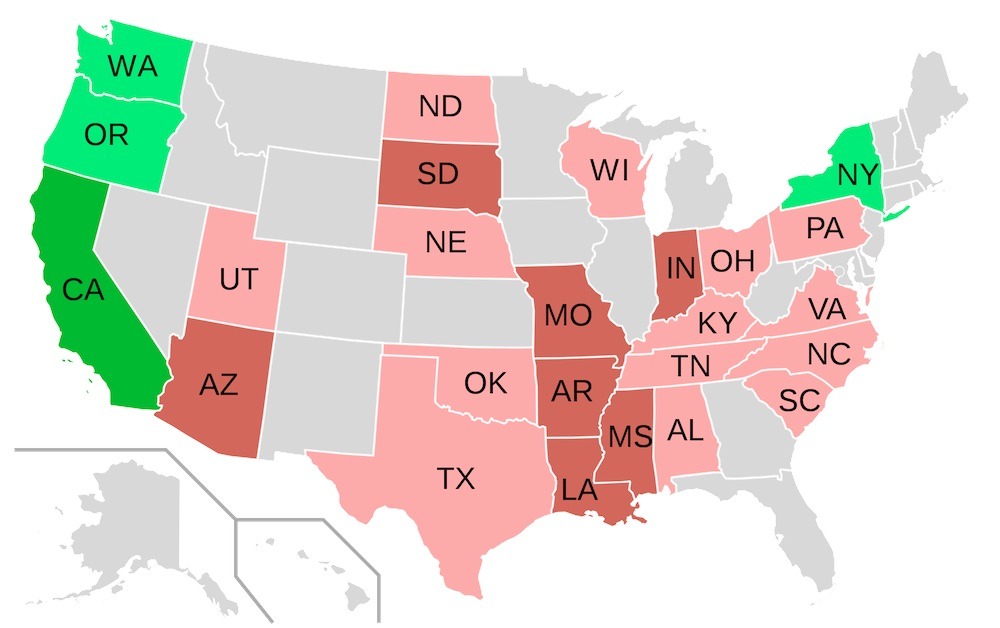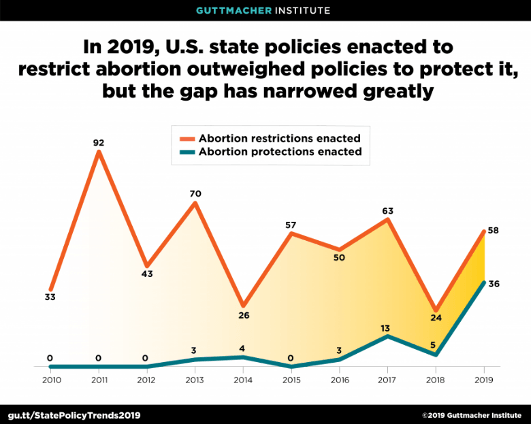
February 24, 2020; Colorlines
For the first time since the Population Institute began issuing its annual State of Reproductive Health and Rights: A 50-State Report Card eight years ago, the United States has received an overall grade of “F.” For many, this will come as no surprise. States across the country have been enacting draconian restrictions on reproductive healthcare.
Indeed, sometimes there seems to be a race among states to see which one will get the US Supreme Court to overturn Roe v. Wade and free states to outright outlaw abortion. This report, issued by the Population Institute, grades each state on areas that should be of concern to everyone who cares about the health and wellbeing of women and children in this nation. And when the overall grade for the country moves from a D- to an F, one can hear the doomsday clock ticking.
The criteria used to “grade” each state focus on three areas: the affordability of reproductive health care services, the rates of teenage and unplanned pregnancies, and access to contraception and abortion care. According to the report, 2019 was not a good year for these criteria in many states, due to federal mandates that were implemented at the state level and then combined with state actions.
There were many federal setbacks in 2019, most notably, the finalization of a new set of rules for Title X, the 50-year old federal-state partnership that supports family planning clinics serving low-income households. Frequently referred to as the “domestic gag rule,” the new rules prohibit Title X family planning physicians and staff from counseling patients on abortion or referring them to abortion providers. In response to the new regulations, Planned Parenthood and other abortion providers dropped out of the program.
Not only were states left without or with fewer Title X providers, those providers that remained faced a new onslaught of TRAP (Targeted Regulations for Abortion Providers) laws coming from their state legislatures. According to the Guttmacher Institute, 2019 saw an unprecedented wave of abortion bans, with 25 new bans being signed into law in states mostly in the south and the Midwest. These are states that, to no one’s surprise, received consistently low grades from the Population Institute. But all was not bad news. The Guttmacher Institute also tracked policies enacted by states that would protect abortion rights. The chart below shows the gap between those 2019 policies that would restrict and protect abortion rights.
Sign up for our free newsletters
Subscribe to NPQ's newsletters to have our top stories delivered directly to your inbox.
By signing up, you agree to our privacy policy and terms of use, and to receive messages from NPQ and our partners.

As we look, state-by-state, at how states are promoting reproductive health and rights and how they are promoting or restricting access to these important health services, there is a very deep divide between states in this nation. The report notes this clearly in its introduction:
Since 2010 almost 500 abortion restrictions have been passed at the state level. These changes along with other restrictions on access to reproductive health care have created a landscape in which your ability to access reproductive health care is increasingly dependent on where you live. Our report card makes clear that we have become the “Divided States of Reproductive Health and Rights.”
While 23 states received a grade of “B” or higher, 24 states received a grade of “D” or lower. And it should be noted, that among those lower grades were 16 states receiving an “F-minus.” There is no “curve” in scoring for these grades. There is a 100-point score divided into these four areas:
- EFFECTIVENESS (30): The percentage of unintended pregnancies and state teen pregnancy rate;
- PREVENTION (25): Is there comprehensive sex education in the schools? Are nurses able to dispense medications? Are minors allowed to consent to contraceptive services?
- AFFORDABILITY (25): Is birth control affordable to everyone; Does insurance cover abortion services?
- ACCESS (20): Does the state impose burdensome requirements on those seeking family planning or abortion services?
The report explains in more detail how these criteria are further broken down and scored. This is not a simple test. But in the end, the results are clear. The roadmap for reproductive healthcare in this country is complex and depends greatly on where you live and what your means are. If you live in a rural area, in a state with a score of “D” or “F,” or are low-income or a person of color, this report is not good news. Your access to reproductive healthcare may be limited, to say the least. As Jennie Wetter, Population Institute’s director of public policy, says, “This report card is a call to action for all those who care about reproductive health and rights.”—Carole Levine













